9+ Sample Return to Work Action Plan
-
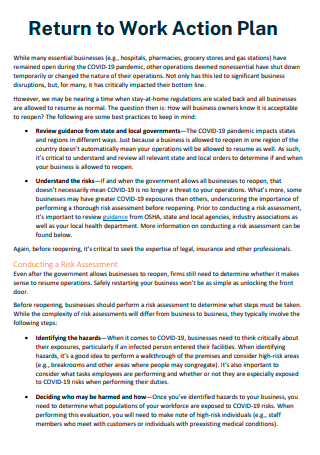
Return to Work Action Plan Template
download now -
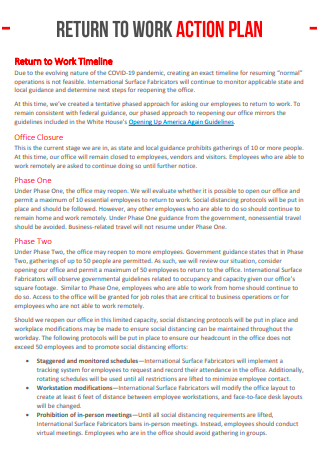
Return to Work Timeline Action Plan
download now -
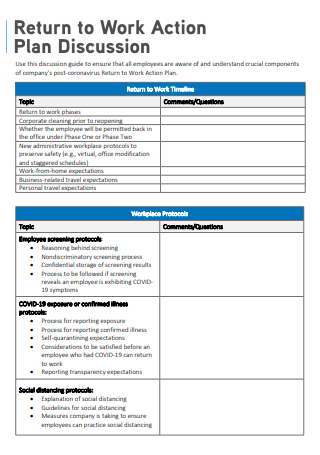
Formal Return to Work Action Plan
download now -
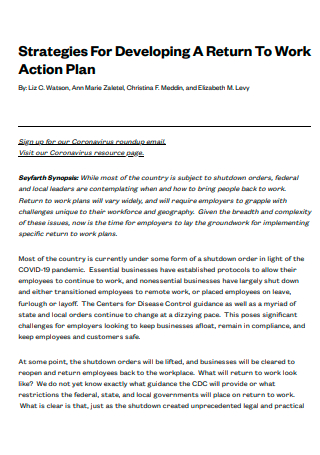
Strategies For Developing Return to Work Action Plan
download now -

Covid-19 Return to Work Action Plan Summary
download now -
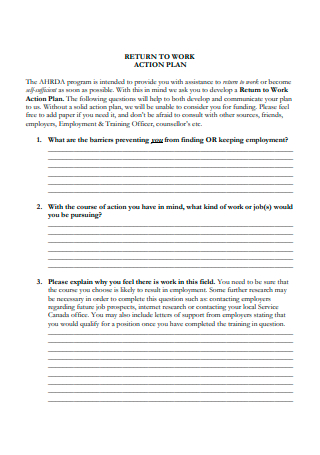
Basic Return to Work Action Plan
download now -

Return to Work Action Plan Example
download now -
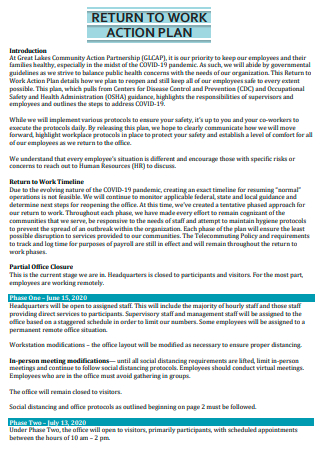
Printable Return to Work Action Plan
download now -
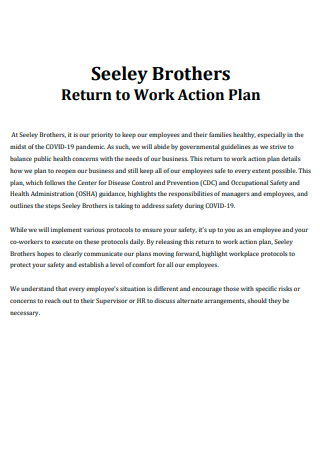
Return to Work Action Plan in PDF
download now -
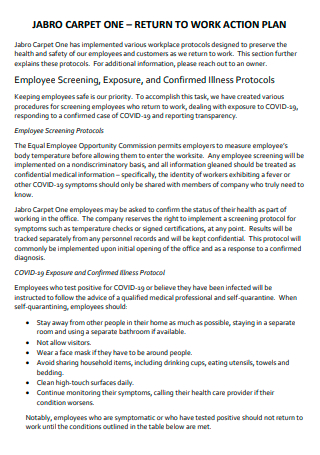
Standard Return to Work Action Plan
download now
FREE Return to Work Action Plan s to Download
9+ Sample Return to Work Action Plan
What is a Return to Work Action Plan?
What are the SMART goals criteria?
Issues or Concerns People Face When Returning to Work
Principles to be Followed for a Successful Return to Work
Step by Step Process in Creating an Effective Return to Work Action Plan
FAQs
Can companies enforce a return to work?
Why is a Return to Work program needed?
What does a general return-to-work plan include?
What is a Return to Work Action Plan?
A return to work action plan serves as a step-by-step checklist that is developed in order to help an employee who has spent a long time away from work or to help a company that has been in a long shutdown period gradually resume their respective duties and business. Being a step-by-step checklist, this plan outlines the necessary steps to be taken by the company and/or employee in order to make sure that the goals set regarding their transition to returning to work, no matter the speed, are achieved. This plan has seen more frequent use nowadays as some businesses prepare their employees to return following a lengthy break due to the pandemic. An effective return to work action plan will help answer questions such as:
- Who are the employees returning on a particular date?
- What changes should the office undergo?
- How to keep the workplace safe?
But in order to be effective, a return-to-work action plan needs to be specific to the needs of the business and workers involved. There is no one size fits all regarding this action plan.
What are the SMART goals criteria?
In developing the return to work action plan and setting its respective goals, the SMART goals criteria can be of massive help. This is what the SMART criteria talk about:
- Specific – goals in the action plan are clear, concise, and must be unambiguous. Goals that are specific have a much higher chance of being achieved.
- Measurable – progress of the goal being worked on should be measurable in order to have some form of reference if the goal is near completion or still a long way away.
- Achievable – goals stated should be attainable, and acceptable for those responsible for achieving them. This will help you figure out ways that you can realize that goal and work towards achieving it.
- Realistic – goals are realistic and relevant to the purpose. It is realistic in a way that the goal can be achieved with the available resources and time.
- Timely – goals should be done in a clearly defined timeline. This is done to create a sense of urgency in achieving it. If it is not time-based, there will be much less motivation to achieve the goal.
Following the SMART criteria in setting goals helps the person push further and helps him/her organize and reach the goals set.
Issues or Concerns People Face When Returning to Work
In the face of the ongoing coronavirus pandemic, going back to work will never be the same again. No matter how ready we think we are, there are still some variables that are present in the real world that will always catch us by surprise. Employees that return to their workspace will always have concerns regarding their safety. And it lies in the companies’ hands on how to appropriately handle it. Here are some issues that they face:
Principles to be Followed for a Successful Return to Work
In normal times, here are the principles that an organization or a company can follow to make sure that an employee’s return to work is as smooth as possible:
Step by Step Process in Creating an Effective Return to Work Action Plan
A well-prepared return to work action plan streamlines the goals stated in the plan and ensures that it is realistic and is achievable. It should also be concisely written and prepared by the company or the respective organization. This return-to-work action plan is essential, especially to those companies that had the misfortune of shutting down offices due to the pandemic. Here are the steps on how to make an effective return-to-work action plan:
1. Plan on ways how to reopen and return to work.
In this step, you can begin to explore the many possible options on how the reopening should go. As an example, you can outline the phases of the reopening of your company or business. The phases are specific to the type of workplace that you have. An example would be starting at Phase 0, where only the employees that are required to physically reopen the office will return to work. The ideal scenario would be ending at a final phase (depending on how many you would prefer) where everyone is back on-site and the workplace is back to pre-pandemic situations. It is also important to plan for contingencies in case something out of control happens during the phases.
2. List down the things to do.
When you have already chosen the type of approach for return to work (such as phasing approach) and its end goal, it is now time to list down the steps that the people involved should take in order to achieve it. Make sure it is clear and concise, and that the tasks that are listed in the action plan are attainable. Should you choose to have a phased approach in returning to work, you can also have a meeting with the people involved in each phase, to determine if they are capable of achieving the tasks listed. If you come across a difficult task, break it down into smaller, simpler steps. If they are not confident enough to achieve it, you can work together with them to come up with the necessary revisions. Tasks can include setting new work policies, establishing employee well-being, and doing everything to foster a safe work environment.
3. Include deadlines or a timetable for the tasks.
To make sure that everyone involved in the tasks being worked on is on track and delivers on the task listed, add deadlines to the action plan. But before you do so, you must also consult with the personnel involved and identify possible barriers or problems that may hinder them from completing certain tasks on time. In the case of contingencies or emergencies, their deadlines should not conflict with the main tasks being listed on the plan.
4. Add milestones.
By adding milestones to the return-to-work action plan being created, it enables all parties involved in doing the tasks to have something to look forward to something and helps them maintain their motivation as they slowly but surely work their way up each task, even if the final one is a long way away. It’s also recommended to not bunch up milestone dates in the plan, and space them weeks, not days apart.
5. Follow up on the progress.
Throughout the course of the tasks being performed, or the phases of the action plan, it is also essential to ask for a follow-up and evaluate the progress. Mark the tasks that are completed, and tick them off the appropriate checklist. You can also point out and discuss with the staff if there are any unfinished tasks, so you can find possible solutions. Should there be any unforeseen difficulties or contingencies in completing the task, modifications to that certain task can also be performed to ensure that it is completed and the goal gets closer to being achieved.
FAQs
Can companies enforce a return to work?
Even though restrictions regarding working remotely are slowly being lifted nowadays, the employees should still have the freedom in deciding whether to continue working from home or resume working on-site. If an employer presents an offer to the employee to return on-site, the employee should still be able to refuse and opt to work remotely if concerns are still present in his/her mind about the overall safety of the workplace and the commute that comes with it. Should the company make an offer about returning on-site, they should also ensure that proper measures are already in place so that the employee does not think twice when making a decision.
Why is a Return to Work program needed?
A return to work program is needed for the following reasons (but not limited to):
- It is needed to maintain relationships with co-workers and to keep the working skills updated.
- It is needed to maintain an employee’s emotional well-being.
- In the case of an ill or injured employee, a return to work program is needed in order to speed up their recovery and get back up to speed on normal duties and responsibilities.
In a typical return to work program, an employee who has been disabled or partially disabled due to an injury can still opt to continue his/her role, although with modifications in place in order to make the job still doable for the employee. Other alternatives to this can be a different job in the same workplace, a similar job in a different workplace, or a totally different job at a totally different workplace.
What does a general return-to-work plan include?
A return-to-work plan can include the following details:
- The employee’s objectives, which are to be gradually met until the goal of fully performing the task or tasks to pre-absence level, or until a new job is started should a return to the previous one prove impossible.
- The actions required to meet the objectives that are listed.
- The time frame needed to complete the objectives. They must respect the abilities of the returning employee and be clearly stated, as well as being revisable if needed.
- Actions that are taken if there are difficulties that are encountered while performing the task.
A return-to-work plan is intended to be only transitional and typically only has a fixed duration, whether it is short-term or long-term. This differs from an accommodation because the actions taken in an accommodation are permanent.
Businesses and companies nowadays are slowly transitioning to the return to work phase. Employees that are returning should not feel bad if they have any concerns regarding their return to work especially if it centers on their safety and well-being. Employers should not practice pressuring employees to immediately return to on-site work if they are still uncomfortable or doubtful of their situation. Transition programs can always prove to be difficult for everyone, including the employers themselves. Having adequate planning helps ease the burden of returning to work. In this article, there are examples provided above on how a proper action plan looks like for this scenario.
